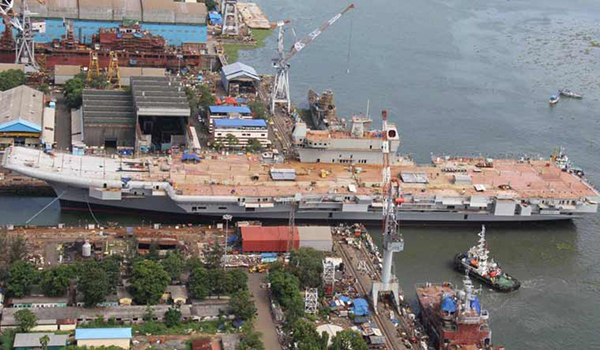The commissioning of the Indian Navy’s indigenously-built aircraft carrier INS Vikrant on 2 September was an important milestone.
It is the first aircraft carrier to be built in India, and represents the country’s growing capabilities in naval shipbuilding. As a symbol of national pride and military power, the INS Vikrant is an important component of India’s strategic defence capabilities. The aircraft carrier will play a crucial role in India’s ability to project naval power and defend its interests in the Indian Ocean region. It will also be a major boost to the Indian Navy’s Blue Water capability.
Building an aircraft carrier is a highly complex and challenging task that involves several factors. Aircraft carriers are some of the largest and most complex ships ever built, requiring advanced engineering and design capabilities to ensure they can withstand the stresses of prolonged use at sea. Building an aircraft carrier requires advanced shipbuilding techniques, and the use of specialized materials such as steel and aluminum. The process also requires a large workforce and a significant investment in infrastructure.
An aircraft carrier must have a wide range of systems and equipment, including propulsion systems, navigation and communication systems, weapons systems, and aircraft launch and recovery systems, all of which must be integrated and tested to ensure they work together seamlessly.
Building an aircraft carrier is an extremely expensive endeavor that requires large investments in research and development as well as construction. The construction of an aircraft carrier is time-consuming process, it usually take years to complete.
There are several arguments in favor of having aircraft carriers as a part of a country’s naval fleet besides providing the ability to project naval power and influence over long distances, allowing for rapid deployment of military assets in response to global crises and emergencies.
Aircraft carriers provide the navy a blue water capability to operate far from home ports, allow for the deployment of fighter jets and other aircraft, which can provide air support to other naval vessels and ground troops, as well as conduct reconnaissance and strike missions. Along with their accompanying strike groups, aircraft carriers can be used to assert naval control over a specific area of the ocean, enabling a country to maintain sea lanes of communication and protect its own shipping.
Aircraft carriers can serve as powerful symbols of a country’s military strength and capabilities, and can be used to exert diplomatic pressure in international relations.
While aircraft carriers have many advantages, there are also several arguments against having them, the biggest of them being their vulnerability to attack from submarines, missiles, and other weapons. Their loss could be a significant blow to a country’s military capabilities. Aircraft carriers are also specialized platforms, designed for specific roles and missions. This can limit their flexibility and make them less adaptable to changing strategic situations.
The composition of a carrier strike group can vary depending on the specific mission. It may typically include escort ships to provide air and missile defence, submarines, supply ships, amphibious ships, aircraft, : The carrier carries a complement of aircraft, including fighters, bombers, and surveillance aircraft capable of conducting a wide range of missions, helicopters, and support vessels.
Aircraft carriers are vulnerable to a variety of threats, including submarine-launched torpedoes, cruise missiles and special forces; land and sea-based missiles; mines; suicide attacks by terrorists and cyber attacks.
Protective measures inclrease the complexity of operating carrier groups. Escort ships, anti-submarine warfare measures, air defence systems, electronic warfare support measures, decoy systems, cyber defence measures, are all essential.
The design development and construction of an aircraft carrier requires some critical technologies.
Advanced materials such as high-strength steel and aluminum alloys, powerful propulsion systems, flight deck technologies, Air Traffic Control systems, catapults and launch systems, advanced modeling and simulation, are some of the essential technologies, which can become obsolete quickly, making them less effective over time and not able to keep up with the rapid changes in naval warfare technology.


















